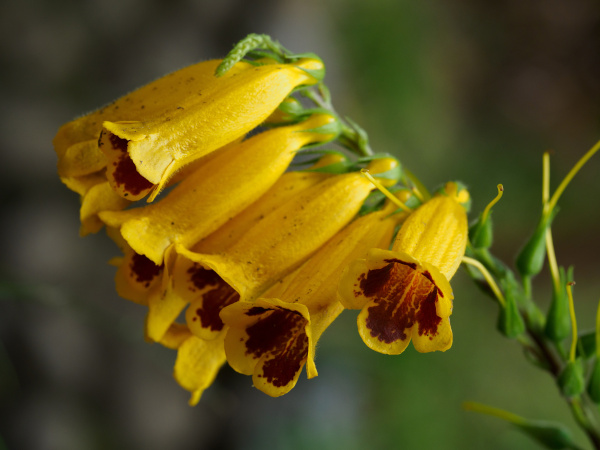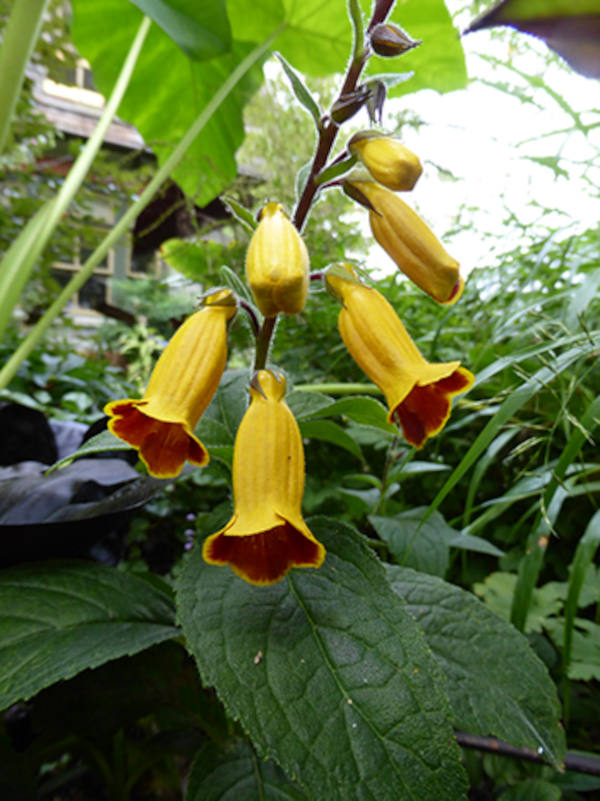How to grow Titanotrichum
Native to Taiwan and China, Titanotrichum has made its way to UK lands in the last 20 years - its native growth region makes it tolerant to cold temperatures as well as humidity. In the UK, Titanotrichum is still a rarity and is often available in limited qualities. However, if you can get your hands on this unique hardy and rhizomatous plant, you will benefit from stunning foliage and foxglove-like flowers in the autumn.
Also known as Chinese Foxglove, Titanotrichum only has one species: Titanotrichum oldhamii. Titanotrichum is clump-forming and has dark purple stems with pendulous yellow flowers and red throats; its fleshy and erect stems grow up to 40cm in height, making it perfectly positioned at the front of a garden border. Grow with 30cm spacing between plants to let its keen rhizomes spread.
Titanotrichum is an easy-going plant that loves water! So, keep the soil moist at all times - moisture-retentive soil can help with this. As an herbaceous perennial, it dies back over the winter and does not need cold protection unless temperatures fall lower than -10°C. With just 2-5 years to fully mature, Titanotrchum is truly one of a kind - as one of a few hardy rhizomatous gesneriads in the world.

Key Information
Soil pH
Position
Hardiness


Where & when to plant Titanotrichum
As a rare plant with limited availability, you will want to try to get your hands on a young potted Titanotrichum. Grow Titanotrichum in a container or at the front of a bed or border for best results. It will appreciate a shady position with plenty of moisture-retentive soil.
How to plant Titanotrichum
Plant Titanotrichum in the front of a border in the spring. This ensures that the soil is moist, frost-free and your plants will have warmer weather to grow in
Prepare the soil by digging a hole about 2 times wider and deeper than your young Titanotrichum plant. Make sure the soil in the border is moisture-retentive without having the plants in standing water - you may need to provide some drainage in the form of grit or sand
Backfill with soil and water in. Afterwards, water at least once a week to keep the soil moist. Water more often during dry spells or when it is particularly warm outside to prevent the soil and plant from drying out and the plant from wilting.
What to plant with Titanotrichum
As lovers of moist soil and partial shade, pair Titanotrichum with similarly hardy perennials. The mature height of the Titanotrichum is approximately 40cm tall, so it can be safely grown at the front of a border. Taller, shade-loving perennials that you could consider pairing with Titanotrichum include Japanese anemone - a 90-100cm tall Asian plant and autumn bloomer - ‘Japanese Toad Lily’ - an 120cm tall shade-loving late-summer bloomer - and 240cm tall Hydrangeas, adding perfectly purple hues.



How to care for Titanotrichum
Pruning & Deadheading
While nothing specific is needed, you should always cut away any darkened, diseased or damaged leaves once the flowering period is over.
Watering
Titanotrichum requires moist soil and tends to wilt quickly if unwatered. Be particularly careful in periods of warm temperatures, extra sun or dry spells, as your Titanotrichum will need watering more regularly than usual - do not allow the soil to dry out.
Cold Protection
Surprisingly, Titanotrichum is hardy and tolerant to temperatures as low as -10°C once established. However, if potted in a container you can bring it indoors over the winter to protect from harder frosts as the plant is dormant in the winter.
Pests & Diseases
While watering is crucial for Titanotrichum, overwatering can lead to root rot. So, moisture-retentive soil is critical for this plant. There are no huge pest or disease concerns when it comes to Titanotrichum, but always be mindful of slugs and snails; look out for silvery trails and irregularly shaped holes in leaves as warning signs.
How to propagate Titanotrichum
The most effective way to propagate Titanotrichum is by division. As it can be difficult to encourage flowering, ‘cloning’ the plant by dividing a parent gives you the best chance of raising a healthy Titanotrichum in your garden.
Start by gently removing the parent plant from its soil and pry away some of the roots using clean scissors or a sharp gardening knife. Do not take away more than ⅓ from the parent plant, and re-plant the parent as soon as you are able
Add your roots to a pot with cuttings compost and water in. You will need to grow the divisions indoors in a more controlled environment. Water the soil regularly while the plant establishes and regularly mist the foliage to keep it moist
By the next spring, your cutting(s) will be ready to plant outdoors as they will have established their own roots. Remember to find a shady position with good soil for your Titanotrichum.
Common Titanotrichum Questions
How should I take care of my Titanotrichum?
Find a position for your Titanotrichum that has plenty of shade with some sunlight. Titanotrichum enjoys moist-wet soil, so keep it watered regularly and do not be scared to add more water to the soil if the weather is hot.
How tall can Titanotrichum grow?
Titanotrichum can grow to heights of 45cm - this is considered low-growing.
Can Titanotrichum be grown in the UK?
Yes. While notoriously tricky to flower, Titanotrichum has been grown in the UK successfully for many years now. Interestingly, this unusual plant has been found to be fully hardy even at 200m on the Scottish borders!




